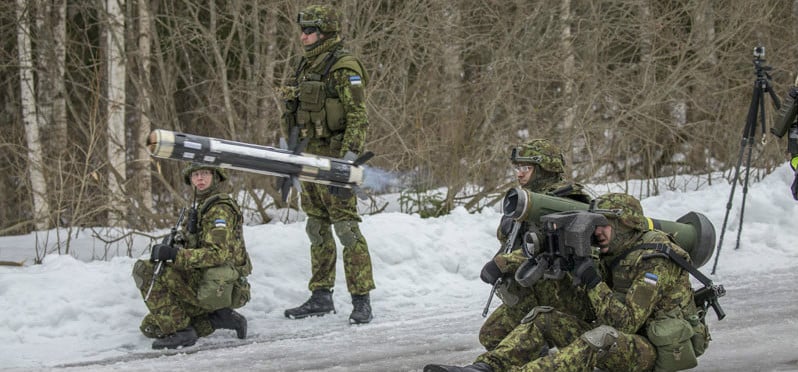
Estonian troops exercise with the US-made Javelin anti-tank missile.
WASHINGTON: The Estonian government is preparing the release of a new 10-year defense strategy in 2020 that will outline the small Baltic nation’s strategic vision and acquisition priorities up to 2030.
While it’s unlikely there will be any big surprises — Russia remains the region’s primary potential threat, and NATO its largest international security partner — Estonia will likely ramp up its investments in US and Western kit to replace the old Soviet-era equipment it was saddled with at the end of the Cold War.
Just this month, Estonia inked a deal with Iowa-based firearms manufacturer Lewis Machine Tool Company for 16,000 new rifles which will begin arriving next year. The contract will ensure that the older Russian arms used by soldiers and police will finally be phased out, along with used weapons the country purchased from Israel in the 1990s.
The contract, valued at around $24 million, will 5.56mm and 7.62mm automatic weapons akin to what the company has supplied New Zealand and British SAS commandos.
“It’s a big deal both for Estonia and the company,” Estonian Ambassador to the US, Jonatan Vseviov, told me recently. Mindful of the Trump administration’s push for allies buying American, Vseviov pointed out that the deal is “helping to create jobs here and strengthen the trade relationship between our countries, at the same time we’re strengthening NATOs defenses on the Eastern flank.”
Estonia is one of only eight NATO nations that spends the goal of 2 percent of its GDP on its military, and more significantly Vseviov said, “we spend a huge portion of the defense budget on acquisitions,” or about 40 percent of its $670 million defense budget. In 2019, the country spent 2.13 percent of its GDP on defense, and is on track to spend about 2.5 percent by 2030.
“The focus is to build and equip a force we can sustain,” Vseviov said. “And that means a force that can exist on the land. With a country of 1.4 million people we simply cannot operate in all the domains as much as we would like and need. That is why we rely on allied support.”
Out of simple economic and demographic necessity, Estonia has focused on buttressing the capabilities of its ground forces instead of jumping into the much more resource-heavy arenas of fourth and fifth-generation aircraft and warships, but has offered the use of runways for the NATO Baltic air policing mission, and hosted the amphibious landing segment of NATO’s huge BALTOPS exercise last month.
But spending on ground capabilities has been focused, and constant.
Last year, Estonia purchased 155mm howitzers from South Korean company Hanwha, along with 155mm ammunition from Finland. Around the same time, the country agreed to buy a short-range air defense system from the French MBDA Missile Systems for $59 million. The army also made investments in purchasing the US-made Javelin anti-armor system.
Earlier this year, the country received the final batch of 44 Swedish-made CV-90 infantry carriers from The Netherlands, giving the Estonian army one of the world’s most sought-after armored troop carriers.
In May, Estonia also signed a five-year defense cooperation agreement with the US. While many of the specifics of the deal are yet to be worked out, a Defense Department release said they will include “capability development and defense-related aid, training exercises, cyber defense, the Estonian Defense League, training areas and host nation support.” The deal comes as a result of the November 2018 US-Baltic Strategic Dialogue. Both Lithuania and Latvia signed similar agreements with the United States this spring.
In an innovative project spearheaded by NATO, the country is part of a group of 16 allied nations which came together in 2018 to pool resources for purchases a variety of ground-launched munitions. Dubbed the Land Battle Decisive Munitions project, the idea is for individual countries to share munition stockpiles, allowing each country to lower their acquisition costs and allow smaller countries to pack a larger punch in the aggregate.
“The NATO alliance has woken up and is taking these challenges seriously,” the ambassador said. Taking note of the increased defense spending across most of the alliance, he added “we are collectively putting our money where our mouth is. Working on a collective defense is at a significantly higher level than it was a few years ago, and that is all a result of Russian aggression in Ukraine and malign activities elsewhere.”
Connecticut lawmakers to grill Army, Lockheed about job cuts at Sikorsky helicopter unit
“The Connecticut delegation has questions about why, with that [FY24] appropriation in hand, this happened,” said Rep. Joe Courtney, D-Conn.


























